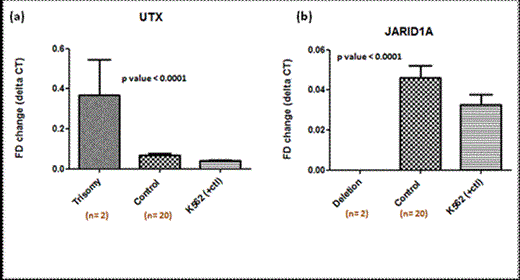Abstract
Introduction
Discovery of cytogenetic abnormalities together with specific aberrations in RNA splicing, cell signalling, translational regulation and tumour suppressor genes are increasingly been applied for the prognostic stratification well as understanding the pathobiology of myelodysplastic syndromes (MDS) and acute myeloid leukaemia (AML).Epigenetic regulation of transcription has attracted particular attention, because of the efficacy of DNA methyltransferase and Histone deacetylase inhibitor therapies for the treatment of both MDS and AML. The Jumonji (JMJ) family of histone demethylases are epigenetic regulators that demethylate lysine residues of histones in a site and methylation state specific context. Given the importance of these in the transcriptional machinery of myeloid progenitors, we examined the role of seventeen Jumonji genes; JARID1A-1D, JARID2, JMJD3, UTX, JMJD4, JMJD2A-2D, JMJD1A-1C, JHJDM1A-1B in the bone marrow samples from patients with MDS/AML. Majority of the genes tested are involved in the demethylation of H3K4, H3K9, H3K27 or H3K36 histone tails while others associate with the polycomb repressive complex (PRC), abnormalities of which are well documented in both MDS/AML.
Methods
SNP6 array karyotyping was carried out in 124 MDS patients [M/F ratio = 1:1.7, median age= 69 yrs, WHO subtypes: RCMD 21%, RAEB I/II 50 %, AML 1%, sAML/tMDS 16 %, CMML 6.5 %, MDS/MPD 5.5 %], focusing exclusively on the Jumonji genes loci to identify copy number variations [CNVs] (deletion/ gain) & Uniparental disomy. The patients with SNP6 aberrations in the Jumonji genes were examined by 454 DNA parallel sequencing and Real-time PCR for mutational analysis and alterations in gene expression respectively. The sequencing depth was 350-450 reads / amplicon.
Results
Of the 124 cases, 28 patients (22.5%) were identified with a deletion, gain or UPD at 15/17 Jumonji gene loci while two genes showed no SNP6 abnormalities. Of the 22.5 % patients, the highest frequencies of deletions were found in JMJD1B (chr 5q31.2) [41 %], JARID2 [10.7 %] and JMJD3, JMJD2D, JMJD1A [7.14 %] each. On the other hand, the highest frequency of gain was observed in JMJD2C [10.7 %], followed by JMJD2A & UTX [7.14 %] each. Interestingly, only three genes showed both deletion and amplification in different patients in our cohort (JARID2, JMJD4, and JMJD2D) while the rest were either deleted or amplified. Compared to CNVs (69 %), only twelve patients (44 %) carried UPD [telomeric, size: majority were >20Mb]. JMJD2D and JMJD4 had the highest frequency (14.3 %) while JMJD3 had [10.7 %] of UPDs. 454 DNA parallel sequencing of the fifteen Jumonji genes in the 28 patients with SNP6 abnormalities revealed no mutations. To elucidate changes in gene expression as a result of CNVs; two patients with CN gain at the UTX locus showed 5 fold increase (p value < 0.0001) in the expression of this gene while two patients with deletion at the JARID1A locus showed knock down in the expression levels as compared to patients with normal SNP6 profile (n =20).
Conclusion
In summary, 22.5 % of high-risk MDS patients show SNP6 aberrations at the Jumonji gene loci. No mutations were associated with the SNP6 abnormalities even with a read depth of 350-450 reads/ amplicon. However, alteration in the expression of JARIDA and UTX was consistent with the CNVs detected on SNP6 which might have direct consequence on the methylation status of the genome or may assist as yet unidentified targets in the pathogenesis of MDS.
(a) Five-fold increase in UTX expression in two patients, one with trisomy chr: Xp and second with CN=4 (b) Knock down of JARID1A expression in two patients with CN=1 in compared to twenty control patients with normal SNP6 profile at the UTX and JARID1A loci. cDNA from K562 cell line was used as a positive technical control in all experiments.
(a) Five-fold increase in UTX expression in two patients, one with trisomy chr: Xp and second with CN=4 (b) Knock down of JARID1A expression in two patients with CN=1 in compared to twenty control patients with normal SNP6 profile at the UTX and JARID1A loci. cDNA from K562 cell line was used as a positive technical control in all experiments.
Shinde:Celgene: Research Funding.
Author notes
Asterisk with author names denotes non-ASH members.



This feature is available to Subscribers Only
Sign In or Create an Account Close Modal